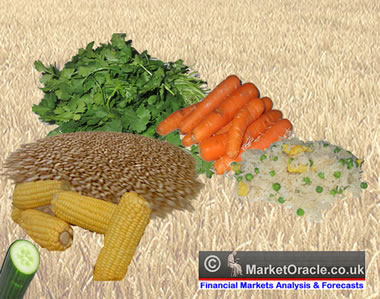No Bubble in Agricultural Commodities
Commodities / Agricultural Commodities Apr 17, 2008 - 12:57 PM GMTBy: Michael_Pento

 All investors have become contrarians and are now experts in being able to spot bubbles. Hence, they all are fully aware that a bubble exists in agricultural commodities at this juncture. Really, you can listen to just about any financial source and hear someone warning about the epic bubble that is evident in agricultural commodity prices. However, some of these same folks were completely blindsided by the collapse of the tech bubble in 2000. And they also were shocked that real estate prices could ever decline in value. Of course, this new class of maverick investor is also currently incapable of viewing the real bubble occurring in the Treasury market (it doesn't bother them that real yields on government debt are negative). The only thing they are sure of is that agricultural prices are poised to plummet.
All investors have become contrarians and are now experts in being able to spot bubbles. Hence, they all are fully aware that a bubble exists in agricultural commodities at this juncture. Really, you can listen to just about any financial source and hear someone warning about the epic bubble that is evident in agricultural commodity prices. However, some of these same folks were completely blindsided by the collapse of the tech bubble in 2000. And they also were shocked that real estate prices could ever decline in value. Of course, this new class of maverick investor is also currently incapable of viewing the real bubble occurring in the Treasury market (it doesn't bother them that real yields on government debt are negative). The only thing they are sure of is that agricultural prices are poised to plummet.
This sophomoric conclusion focuses on just the increase in commodity prices, yet ignores some key factors that must be present for a bubble to exist. For an investment to reach bubble territory there must first be a dramatic increase in the quantity of the investment in question. Once demand contracts, an environment ensues where a massive oversupply imbalance in the investment out strips intrinsic demand by a great degree.
The two most recent actual bubbles offer great examples to this phenomenon. The tech bubble produced massive increases in stock issuance that exceeded the real demand for such equities, and the creation of new shares had a virtually unlimited supply constraint. Likewise, new home construction companies increased production rates to over 2mm units per annum, which grossly oversupplied the intrinsic demand of just 1.15mm units needed to house the growth in population. Once demand returned to historic levels, the excess inventories become a massive overhang on the market pushing prices down precipitously—an environment which persists today.
The question investors must ask themselves is whether a condition of oversupply now exists in agricultural commodities. In fact, the evidence shows just the opposite situation exists. If there was a bubble, the amount of land available for crop production would be expanding rapidly. In actuality, China has lost 6.6% of arable land in the past 10 years. Globally, we have less than half the amount of arable land per capita available for production since 1950. If crop prices were poised to fall, then inventories would be surging, yet we find that inventories for most crops are at or multi-decade lows while stock to-use ratios are also extremely thin. That hardly represents an environment where investors should fear pricing pressures.
The fact is that the food supply cannot be readily increased in short order, and the World Bank would is estimating that 33 countries face civil unrest and riots due to food emergencies. If the price and quantity of agricultural commodities could be easily manipulated, then we would not be seeing shortages breaking out on a global level. The truth is that the demand for these commodities is far more genuine then it was for house and stock flippers.
Although the world's productive agricultural capacity will one day catch up, land and infrastructure challenges around the globe will make it much more difficult for growers to increase the crop supply as easily as Wall Street was able to flood the market with new homes and equities.
On the demand side, we see that the Global need for food is projected to increase by 50% in the next 20 years. Outside of cutting subsidies for ethanol production, which seems highly unlikely, this projected future demand for food cannot be decreased substantially. Plus, there is no evidence at all that today's demand for food is artificial or temporal in nature, nor is there evidence that a major supply of crops is about to hit the market.
Ask the citizens of Egypt, Cameroon, Ivory Coast, Senegal and Ethiopia if their demand for food is real or speculative. Bottom line is people don't riot when all they want to do is speculate, they riot when they are hungry and cannot find or afford food to eat.
No, the increased demand for agricultural goods is real, as is the supply constraint facing the market. Investors may choose to ignore the massive growth in earnings that are being reported by Monsanto (MON), Potash (POT), Mosaic (MOS) and others that service the agricultural industry.
But sorry, no bubbles will be found there.
Michael Pento
Senior Market Strategist
Delta Global Advisors
800-485-1220
mpento@deltaga.com
www.deltaga.com
With more than 16 years of industry experience, Michael Pento acts as senior market strategist for Delta Global Advisors and is a contributing writer for GreenFaucet.com . He is a well-established specialist in the Austrian School of economic theory and a regular guest on CNBC and other national media outlets. Mr. Pento has worked on the floor of the N.Y.S.E. as well as serving as vice president of investments for GunnAllen Financial immediately prior to joining Delta Global.
Michael Pento Archive |
© 2005-2022 http://www.MarketOracle.co.uk - The Market Oracle is a FREE Daily Financial Markets Analysis & Forecasting online publication.


